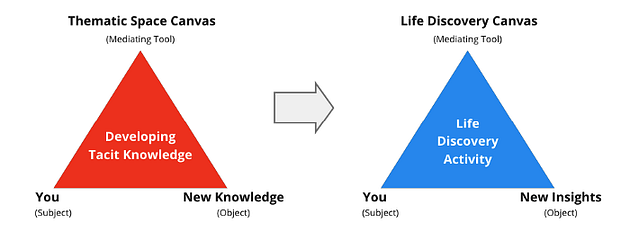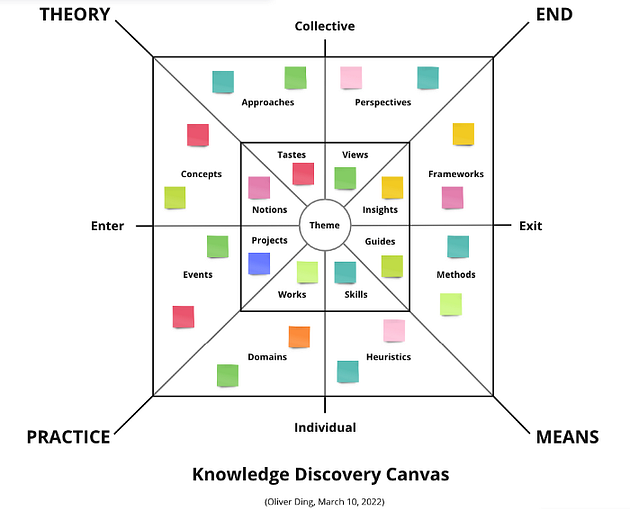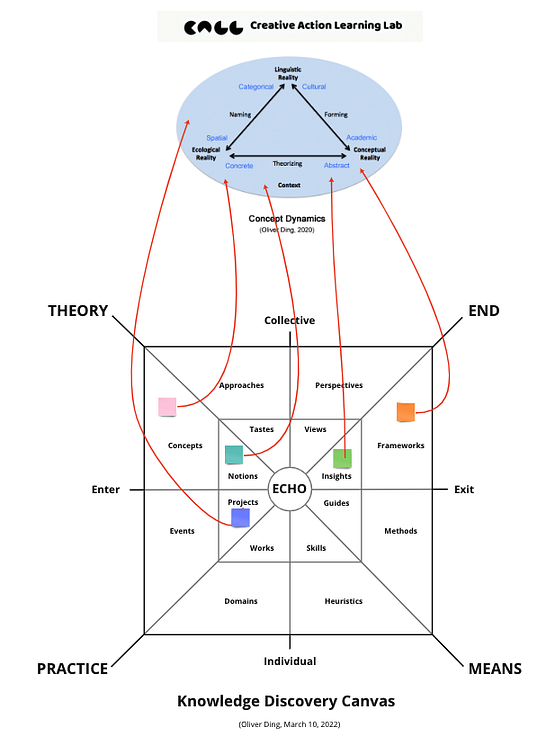Knowledge Discovery (Possible Book, 2022)

Developing Tacit Knowledge with the Thematic Space Canvas
by Oliver Ding
May 19, 2022
Over the past four months, I have worked on the Slow Cognition project, which aims to explore the historical-cognitive approach and the long-term development of thought. I adopted two main strategies in this project:
- Historical-Cognitive Analysis — I use my own real-life experience as data for analysis. During the past four months, I have recorded my ideas and written many articles on Medium. These records and reflections document the long-term evolution of my thinking.
- Reflective Practice — Drawing on Donald Schön’s reflective approach, I analyze and interpret the development of my thoughts during this period.

The central project in this phase has been the Thematic Space Project. Initially, I used the term Thematic Space as an item within the Knowledge Curation Model and its accompanying canvas. Later, I developed a dedicated canvas for the concept itself, which led to a series of derivative canvases and activities, including:
- Knowledge Discovery Activity and Canvas
- Concept Discovery Activity and Canvas
- Life Discovery Activity and Canvas
- Opportunity Discovery Activity and Canvas
- Thematic Spirit
- Significant Insights Analysis
The notion of Thematic Spaces belongs to a broader knowledge enterprise that connects multiple conceptual threads:
- Curativity Theory > Cognitive Container > Knowledge Curation
- Curativity Theory > Themes of Practice
- Life as Activity > Creative Life > Slow Cognition
- Mind as Play > Diagramming as Practice
- Mind as Play > Developing Tacit Knowledge
- Mind as Play > Themes of Practice

In January 2022, I initiated the Slow Cognition Project, structured around the following dimensions:
- Theory: Curativity Theory
- Sub-theory: Themes of Practice
- Framework: Knowledge Curation
- Method: Slow Cognition
- Instrument: Thematic Space Canvas
- Phenomenon: Developing Tacit Knowledge
Within Curativity Theory, Thematic Space is a new theoretical construct embedded in the Knowledge Curation Framework. Since Themes of Practice is a sub-theory of Curativity Theory, Thematic Space also functions as a conceptual element within that framework.
The notion of Slow Cognition refers to the long-term development of thought through a historical-cognitive method. In this sense, Thematic Space provides a concrete tool for transforming Slow Cognition from an abstract concept into a practical project.
My strategy for studying Developing Tacit Knowledge is straightforward: I focus on the long-term evolution of a theme. To borrow Andy Blunden’s term, the long-term development of a theme serves as the germ-cell of Slow Cognition.
A thematic space represents a person’s ideas, activities, and practices centered on a particular theme. A theme can take many forms:
- an established theory (e.g., Activity Theory),
- a general concept (e.g., Platform or Life), or
- an intermediate idea (e.g., Design Thinking or UX).
I have written many articles about Thematic Space, Knowledge Discovery, and their related canvases. I plan to conclude Slow Cognition (Phase I) by editing these articles and developing them into a new book titled Knowledge Discovery: Developing Tacit Knowledge with the Thematic Space Canvas.
The Name
The title of the new book is Knowledge Discovery: Developing Tacit Knowledge with Thematic Space Canvas. This title curates three interrelated concepts, each carrying a distinct meaning.
- Knowledge Discovery: I draw a distinction between Knowledge Discovery and Knowledge Production. While the outcome of Knowledge Discovery is Significant Insight, the outcome of Knowledge Production is Knowledge Products. Moreover, Significant Insight often leads to Knowledge Production. From the perspective of the Anticipatory Activity System, Knowledge Discovery can be regarded as a second-order activity, whereas Knowledge Production represents a first-order activity.
- Developing Tacit Knowledge: The term Tacit Knowledge was coined by Michael Polanyi in his 1958 book Personal Knowledge, which explores the philosophy of science. Many scholars and researchers describe skills, ideas, and experiences as forms of tacit knowledge. My focus, however, is on the dynamics of Tacit Knowledge. Returning to Polanyi’s original notion of “an active comprehension of the things known,” I use it as the foundation for examining how tacit knowledge develops. Furthermore, I treat Developing Tacit Knowledge as an activity of objective–subjective knowledge curation.
- Thematic Space Canvas: The Thematic Space Canvas is a meta-canvas, and the Knowledge Discovery Canvas represents one of its applications.
Together, these three concepts define the scope and boundary of the new book. I do not engage in the complex theoretical debates surrounding the concept of Tacit Knowledge. Instead, the book focuses primarily on Knowledge Discovery Activity and the Thematic Space Canvas / Knowledge Space Canvas. I also view the development of these ideas as a case study within the Slow Cognition project.
The Perspective
While my primary project is the Knowledge Curation project, my major theoretical interests are grounded in the following approaches:
- The Ecological Practice Approach (inspired by Ecological Psychology)
- The Project-centered Approach (inspired by Activity Theory)
- The Anticipatory Activity System Framework (inspired by Anticipatory System theory)
I often draw upon ideas from these three approaches — and related theoretical traditions — in developing the Knowledge Discovery project. For instance, the Knowledge Discovery Activity is defined through a diagram representing the basic model of Activity Theory: Subject — Mediating Tool — Object.

I regard both Developing Tacit Knowledge and Life Discovery as distinct Activities. From the perspective of Activity Theory, the Thematic Space Canvas (or Knowledge Discovery Canvas) and the Life Discovery Canvas both function as Mediating Tools.
Moreover, I have found that Life Discovery can be understood as a subcategory of Developing Tacit Knowledge when the focus of knowing concerns one’s own life development. In this sense, the process of discovering new insights about life development constitutes a process of Developing Tacit Knowledge.
The Structure
The diagram below illustrates the structure of the new book Knowledge Discovery: Developing Tacit Knowledge with Thematic Space Canvas.

The upper “Network — Container — Platform” triad represents a model from the Ecological Practice Approach. I use it to interpret the “Flow — Story — Model” triad, which emerged from the Knowledge Discovery project.
- Flow: Daily experiences are pieces.
- Story: A story serves as a container for these pieces of experience by providing a theme and defining a boundary.
- Model: A model is also a container — but a stronger one — requiring rigorous cognitive abstraction.
There are six movements between these three states, and each movement corresponds to a specific type of Attachance.
In the Knowledge Discovery project, each article represents a piece. The collection of articles I published on Medium forms the Flow. The Model refers to the Thematic Space Canvas (or Knowledge Discovery Canvas), and the Story is represented by the examples I used in the articles about the canvas.
The new book is organized into the following five parts:
- Part 1: The Activity
- Part 2: The Model
- Part 3: The Story
- Part 4: The Flow
- Part 5: The Insight
The Number
Some numbers about the possible book:
- 5 parts
- 37 chapters
- 42 articles
- Total reading time: approximately 618 minutes
- Total length: about 163,770 words (roughly 328 single-spaced pages)

Part 1: The Activity
Part 1 provides some background on the perspective of Activity Theory and other theoretical resources. Developing Tacit Knowledge focuses primarily on the dynamics of the thematic space. From the standpoint of Activity Theory, I treat Developing Tacit Knowledge as an Activity.
Where does the Developing Tacit Knowledge activity take place? The diagram below highlights a light blue area along the boundary between inner and outer spaces, indicating that this activity is inherently cross-boundary.

According to Kaptelinin and Nardi (2006), Activity Theory is guided by five basic principles:
- Object-orientedness
- Tool mediation
- Internalization — externalization
- The hierarchical structure of activity
- Development
These principles can be applied to analyze the Developing Tacit Knowledge activity. Furthermore, Knowledge Discovery Activity, Life Discovery Activity, and Concept Discovery Activity can all be understood as subtypes within the broader family of Developing Tacit Knowledge.
Chapter 1: The Diagramming as Practice Framework (15 min read)
This chapter introduces the Model of Knowledge Curation, providing an important context for the Thematic Space Project.
Chapter 2: The Dynamics of Tacit Knowledge (17 min read)
Chapter 3: The Art of Continuous Discovery (18 min read)
This chapter presents the development of the Activity U Project (Phase II), which serves as an example of Knowledge Discovery. Phase I of the Activity U Project is considered an example of Knowledge Curation.
Chapter 4: The Second-order Activity (13 min read)
Original article: CALL for LIFE: Oliver Ding @ 2021 and Second-order Activity
Chapter 5: The Mediating Instrument Perspective
Original articles:
- 1. Diagramming as Practice (Part 3A) — 16 min read,
- 2. Diagramming as Practice (Part 3B) — 20 min read
Part 2: The Model
Part 2 introduces the Knowledge Discovery Canvas, originally called the Thematic Space Canvas. In the early stages, I used the term Conceptual Spaces for the Model of Knowledge Curation and its canvas, inspired by Peter Gärdenfors’ 2004 book Conceptual Space: The Geometry of Thought. I used this term to describe large cognitive containers for curating similar theoretical approaches together.
Later, I replaced it with Thematic Space, leading to the Thematic Space Canvas and its applications, such as the Knowledge Discovery Canvas.

In the model of Knowledge Curation, Thematic Spaces are both objective and subjective. A key feature of a Thematic Space is its ability to connect objective theoretical resources with subjective work experience. From the perspective of Curativity Theory, building and developing a Thematic Space represents an Objective–Subjective knowledge curation.
The Knowledge Discovery Canvas is designed along several dimensions:
- THEORY–PRACTICE
- END–MEANS
- ENTER–EXIT
- INDIVIDUAL–COLLECTIVE
The canvas also contains two nested squares that divide the thematic space into INNER space and OUTER space. For Developing Tacit Knowledge, the inner space captures personal knowing activities, while the outer space reflects social interactions. Based on this distinction, I generated mappings between OUTER space and INNER space:
- Approaches → Tastes
- Concepts → Notions
- Events → Projects
- Domains → Works
- Perspectives → Views
- Frameworks → Insights
- Methods → Guides
- Heuristics → Skills
I also use the metaphor Flow–Story–Model to describe the process of the Knowledge Discovery Activity.

The diagram above represents Thematic Space within the context of life development through a simple metaphor: Flow, Film, and Floor Plan.
- Experience > Flow > Life as a continuous flow
- Story > Film > Project as a film with a prominent theme
- Model > Floor Plan > Thematic space as a floor plan
I use “continuous flow” as a metaphor for Life and Experience, inspired by William James’ notion of the “Stream of Thought.” The Story represents the social-communicative layer, where a person can share their journey of developing tacit knowledge with others. I use Film as a metaphor for this layer.
I use Floor Plan as a metaphor for the Model layer, as it evokes three interconnected notions:
- Floor Plan: a cognitive representation of a house’s structure
- House: a physical place containing a family
- Home: a social place containing the life activities of a family
We can now extend this metaphor to describe Thematic Space:
- Floor Plan → Thematic Space: a cognitive representation of the structure of Tacit Knowing Space
- House → Physical Environments: computer, website, whiteboard, etc., containing the canvas and tacit knowing activities
- Home → Social Environments: conversations, meetings, workshops, family, school, company, etc., containing tacit knowing activities
This package offers a systematic model for understanding the Knowledge Discovery Activity with its instruments. Part 2 collects articles about the canvas and related ideas.
Chapter 6: The Notion of Thematic Space (11 min read)
Chapter 7: A Meta-canvas for Developing Tacit Knowledge (12 min read)
Chapter 8: The Objective — Subjective Knowledge Curation
Original article: Mapping Thematic Spaces #1: OS Card and Mapping Clues — 12 min read
Chapter 9: The Spatial Structure of Thematic Space Canvas
Original article: The Life Discovery Canvas (v1.0) — Part 2: Spatial Structure — 15 min read
Chapter 10: Sparks In, Statue Out
Original articles: 1. Thematic Space: Sparks In, Statue Out — 14 min read, 2. Slow Cognition: The Spark Space Canvas — 9 min read, 3. Slow Cognition: Three Canvases for Developing Tacit Knowledge — 12 min read
Chapter 11: Flow, Film, and Floor Plan
Original articles: 1. Thematic Space: Flow, Film, and Floor Plan — 11 min read, 2. Thematic Space: Project as Story — 15 min read, 3. Thematic Space: Place as Container — 13 min read
Part 3: The Story
The Knowledge Discovery Canvas functions as a window onto both the world and the mind.
As a window onto the world, I use 16 terms to define 16 blocks for the Knowledge Discovery Activity. This forms a typology for meta-cognition.
As a window onto the mind, I wrote a series of articles that provide more details for each term, introducing additional typologies. I also used my own experiences as case examples in these articles.
These articles can be considered stories of my personal journey of knowledge discovery and knowledge curation.
Chapter 12: The “Concepts — Notions” Mapping (15 min read)
- Tool: a typology of concepts
- Story: three stories of Concept Curation
Chapter 13: The “Approaches — Tastes” Mapping (14 min read)
- Tool: Niches of Analysis, the Context of Epistemic Development, the “PIN” strategy
- Story: Bonnie Nardi’s choices and boundary knowledge work
Chapter 14: The “Perspectives — Views” Mapping (12 min read)
- Tool: The Mind as Play metaphor and framework, a typology of Perspectives
- Story: The Curated Mind
Chapter 15: The “Frameworks — Insights” Mapping (18 min read)
- Tool: The HERO U framework, a typology of Frameworks
- Story: Six stories of making and using frameworks
Chapter 16: The “Events — Projects” Mapping (10 min read)
- Tool: Cultural Projection Analysis
- Story: 9/11 Curator and Curation for Memorial
Chapter 17: The Domains — Works Mapping (18 min read)
- Tool: Social Systems Model of Creativity, the Epistemology of Domain, the Themes of Practice framework
- Story: The Thematic Space project
Chapter 18: The “Heuristics — Skills” Mapping (22 min read)
- Tool: A typology of Heuristics
- Story: Three stories about making “Deep Analogy”
Chapter 19: The “Methods — Guides” Mapping (21 min read)
- Tool: A typology of Methods, the NICE way
- Story: Four stories of making and using the Creative Action Analysis method

I also wrote some articles about additional tools and strategies:
- The Concept Dynamics Framework (14 min read)
- The HERO U Canvas (10 min read)
- The “Double Theme” Strategy (14 min read)
- The “Middleware” Strategy (12 min read)
- The “Trilogy” Strategy for Knowledge Creators (9 min read)
Part 4: The Flow
I also use Thematic Space to reflect on some of my themes. These reflection reports represent my personal experience. I decided to organize these articles under the section Flow.

Originally, I used “Mapping Thematic Spaces” as a tag for these articles. Now, I consider this tag as a special type of activity. It refers to using the concept of Thematic Space or the Thematic Space Canvas to reflect on the long-term development of thoughts around a particular theme.
Chapter 20: The “Activity” Thematic Space (16 min read)
A case study based on the experience of Developing Tacit Knowledge about Activity Theory.
Chapter 21: The “Platform” Thematic Space (16 min read)
A 91-minute talk leads to a reflection
Chapter 22: A “Strategy-as-Curation” Weekend (19 min read)
One Theme, One Weekend…A new Mandala diagram about Life Strategy for Indie Creators…A temporal slice of a thematic space.
Chapter 23: The “Strategy” thematic space (22 min read)
Strategic Thinking, Strategic Discourse, Strategic Acting, and Strategic Awareness.
Chapter 24: The “Center” Thematic Space (18 min read)
How to start a thematic space from scratch?
Chapter 25: The “Relevance” Thematic Space (18 min read)
When should you update a thematic space?
Chapter 26: The “Life” Thematic Space (35 min read)
Where is the starting point of the process of theorizing something?
Chapter 27: How to record a spark (8 min read)
If you can remember it, you don’t have to record it.
Chapter 28: Some Sparks for the “Infoniche” thematic space (14 min read)
Information, Places, and Actions.
Chapter 29: The Project Engagement Toolkit for Creators (12 min read)
An example of “Toolkit as Knowledge Statue” and possible connections between two thematic spaces.
Chapter 30: The Connected Hub and “Service Thinking” (14 min read)
A Connected Hub is a special thematic space that connects two or more thematic spaces together.
Chapter 31: The First Thematic Spirit (13 min read)
Using Thematic Space Canvas to develop a new canvas about Concept Development.
Part 5: The Insight
Originally, the notion of Significant Insights was developed for the Life Discovery Project. Since this project is part of the family of Developing Tacit Knowledge, I extend the concept to the Knowledge Discovery Activity and other types of Discovery activities.
The Life Discovery Project adopts the notion of Actions–Activity from Activity Theory and identifies three types of actions for the Life Discovery Activity:
- Exploration: detach from the Produce status and attach to the Play status
- Detection: pay attention to cues from experiences and environments
- Recognition: identify significant insights
I also highlight three types of significant insights:
- Detecting Potential Contradictions
- Exploring Potential Themes
- Detecting Potential Opportunities
These principles can be applied to the Knowledge Discovery Activity as well. Part 5 collects the related articles and additionally includes articles on modeling, diagramming, and building a knowledge enterprise, to address the question of how to use significant insights.
Chapter 32: The “Discovery as Development” Principle (11 min read)
Though this article focuses on the Life Discovery Activity, its core ideas are also applicable to the Knowledge Discovery Activity.
Chapter 33: “Points of Observation” and “Significant Insights” (8 min read)
A typology of perspectives and the “changes in Points of Observation” within Thematic Space.
Chapter 34: Significant Insights Analysis (6 min read)
Exploring who is the significant other behind a significant insight and other related issues.
Chapter 35: Modeling A Knowledge Project
Original article: Modeling A Developmental Project — 8 min read. Also includes a real case study: The Activity U Project (2020–2022).
Chapter 36: Knowledge Building and Academic Creativity (11 min read)
Diagramming as a tool for fostering academic creativity.
Chapter 37: How to Grow A Knowledge Enterprise (16 min read)
A model for the Building Knowledge Enterprise Activity and the Path of Creative Life.
